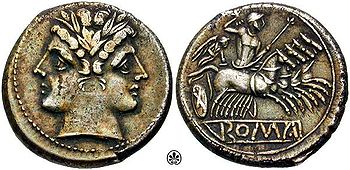
Quadrigatus
Encyclopedia

Roman Republic
The Roman Republic was the period of the ancient Roman civilization where the government operated as a republic. It began with the overthrow of the Roman monarchy, traditionally dated around 508 BC, and its replacement by a government headed by two consuls, elected annually by the citizens and...
during the 3rd century BC. The obverse featured a young janiform bust and the reverse featured Victory
Victoria (mythology)
In ancient Roman religion, Victoria was the personified goddess of victory. She is the Roman equivalent of the Greek goddess Nike, and was associated with Bellona. She was adapted from the Sabine agricultural goddess Vacuna and had a temple on the Palatine Hill...
driving a quadriga
Quadriga
A quadriga is a car or chariot drawn by four horses abreast . It was raced in the Ancient Olympic Games and other contests. It is represented in profile as the chariot of gods and heroes on Greek vases and in bas-relief. The quadriga was adopted in ancient Roman chariot racing...
(four-horse chariot), giving the coin its name, with the inscription "ROMA" below.
The coin weighed about 6.8 gram
Gram
The gram is a metric system unit of mass....
s (6 scruples), consistent with a didrachma. The coin was minted from c. 241 to 235 BC until shortly before the introduction of the denarius
Denarius
In the Roman currency system, the denarius was a small silver coin first minted in 211 BC. It was the most common coin produced for circulation but was slowly debased until its replacement by the antoninianus...
(211 BC). Gold coins of similar style were issued at this time (staters and half-staters) which featured the same obverse type as the quadrigatus and the reverse type of two soldiers performing an oath over a third soldier holding pig, with the inscription "ROMA" below. The choice of Janus
Janus (mythology)
In ancient Roman religion and mythology, Janus is the god of beginnings and transitions, thence also of gates, doors, doorways, endings and time. He is usually a two-faced god since he looks to the future and the past...
for these coins is believed to coincide with the closing of the doors of the Temple of Janus
Temple of Janus
In ancient Rome, the main Temple of Janus stood in the Roman Forum. It had doors on both ends, and inside was a statue of Janus, the two-faced god of boundaries. The Temple doors were closed in times of peace and opened in times of war.The closing of the Temple doors was a very rare event...
, indicating the absence of warfare, a rare occasion. Michael Crawford
Michael Crawford (historian)
Michael Hewson Crawford is a British ancient historian and numismatist.-Biography:Michael Crawford was born in Twickenham on 7 December 1939.He was educated at St Paul's School and Oriel College, Oxford , and the British School at Rome....
, however, has suggested that the janiform head represents the Dioscuri, since Janus is usually a mature and bearded figure.
Roman-era historians
Roman historiography
Roman Historiography is indebted to the Greeks, who invented the form. The Romans had great models to base their works upon, such as Herodotus and Thucydides. Roman historiographical forms are different from the Greek ones however, and voice very Roman concerns. Unlike the Greeks, Roman...
such as Livy
Livy
Titus Livius — known as Livy in English — was a Roman historian who wrote a monumental history of Rome and the Roman people. Ab Urbe Condita Libri, "Chapters from the Foundation of the City," covering the period from the earliest legends of Rome well before the traditional foundation in 753 BC...
and Plutarch
Plutarch
Plutarch then named, on his becoming a Roman citizen, Lucius Mestrius Plutarchus , c. 46 – 120 AD, was a Greek historian, biographer, essayist, and Middle Platonist known primarily for his Parallel Lives and Moralia...
often refer to these early coins as denarii
Denarius
In the Roman currency system, the denarius was a small silver coin first minted in 211 BC. It was the most common coin produced for circulation but was slowly debased until its replacement by the antoninianus...
, but modern numismatic references consider these coins as anonymous Roman silver, produced before the standardization of the denarius around 211 B.C. The name quadrigatus comes from the quadriga or four-horse chariot on the reverse, which was the prototype for the most common designs used on Roman silver coins for the next 150 years.
The victoriatus
Victoriatus
The victoriatus was a silver coin issued during the Roman Republic from about 221 BC to 170 BC. The obverse of the coin featured the bust of Jupiter and the reverse featured Victory placing a wreath upon a trophy with the inscription "ROMA" in exergue....
was a later coin of the same fabric that was valued at half a quadrigatus (3 scruples).

